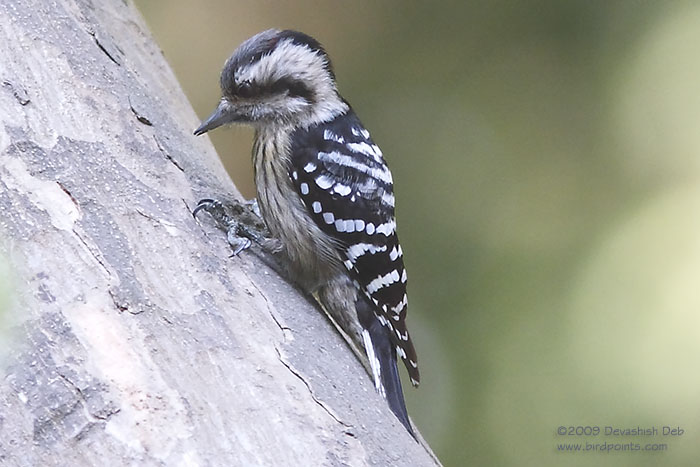|
|
| Grey-capped Pygmy Woodpecker
|
Dendrocopos canicapillus
|
| 6
January 2010 |
|
Possible
regional races (polytypic)
|
|
|
-D. c. mitchellii; Malherbe, 1849
|
|
|
-D. c. semicoronatus; Malherbe, 1849
|
|
|
-D. c. canicapillus; Blyth, 1845 J.A.S.B. 14, p197
Notices and Descriptions of various New or Little Known species of Birds, by Ed. Blyth, Curator of the Asiatic Society's Museum. 9. P. canicapillus, nobis. Diifers from P. moluccensis in the much blacker hue of its upper parts, in the pale ash-colour of the head, a little tinged with brown and bordered laterally with black, from amid which appears the slight crimson sincipital tuft of the male; the size also is rather larger; the wing measuring three inches and one-eighth to three and a quarter, tail one and three-quarters, and bill to forehead five-eighths: the under parts are whitish, purer on the throat, and the rest marked with central dusky black lines. Common in Arracan. |
|
Dendrocopos canicapillus mitchelli
|
|
|
|
Historical notes on Dendrocopos canicapillus semicoronatus
Pls use the mousewheel to zoom in/out (Max 2X)
 Grey-capped Pygmy Woodpecker, Dendrocopos canicapillus mitchelli, female Kaladhungi, Uttarakhand, India, 28 December 2009 Is usually silent with an occasional 'Kik' - DD 973. lyngipicus semicoronatus. The Darjeeling Pigmy Woodpecker. Picus semicoronatus, Malherbe, Bull. Soc. d'Hist. Nat. Moselle, v, p. 21 (1848); Coloration. Male. Forehead and crown ashy with a brownish tinge, occiput scarlet (feathers slightly elongated); nasal plumes and lores fulvescent white; broad superciliary stripe extending back to the side of the neck white, speckled with black, a black line forming a border to the crown above the supercilium, and a brown band, becoming black behind, from the eye to the side of the neck over the lower ear-coverts; nape and upper back and the upper tail-coverts velvety black; remainder of back, rump, scapulars, and wings black with white transverse bars; quills with white spots on both webs, greater and median coverts with white spots or bars, smaller coverts unspotted; the two middle pairs of tail-feathers black throughout as a rule, the two outer large pairs black barred with white above and with fulvescent below, third pair from the middle varying but generally bordered with white; malar region dusky, chin and throat whitish; under surface from throat very light fulvescent brown, with narrow blackish longitudinal streaks; under wing-coverts and axillaries mixed white and black. The female has no occipital red band. Occasionally there are white markings on the upper tail-coverts and small white spots on the median tail-feathers, but this is exceptional. The same occurs in other species of lyngipicus, in which the feathers mentioned are normally black throughout. Distribution. Sikhim, Bhutan, the Khasi and Naga hills, Eastern Manipur, and Yunnan at elevations above about 3500 feet.  Historical notes on Dendrocopos canicapillus mitchellii 974. lyngipicus pygmaeus. The Himalayan Pigmy Woodpecker. Picus mitchellii, Malh. Rev. Mag. Zool. 1849, p. 530. The only important distinction from I. semicoronatus is that in the male of the present species there is no red band across the occiput, but merely a few scarlet feathers forming a short, very narrow, longitudinal stripe bordering the occiput on each side. There is no constant difference in the females, but as a rule the dimensions of I. pygmaeus are rather larger, and the white bands and spots on the upper surface are more developed. Distribution. Forests of the base and lower valleys of the Western Himalayas from around Katmandu in Nepal to Mussooree. Habits, & c. According to Mr. R. Thompson this Pigmy Woodpecker breeds in the dense forest districts of the bhabar and lower valleys of Kumaun in April and May, laying 4 or 5 eggs. The birds migrate into cultivated districts in winter. |
About/Terms
of use etc. in the home page
Copyright ©
2006-2010 birdpoints. All rights reserved.